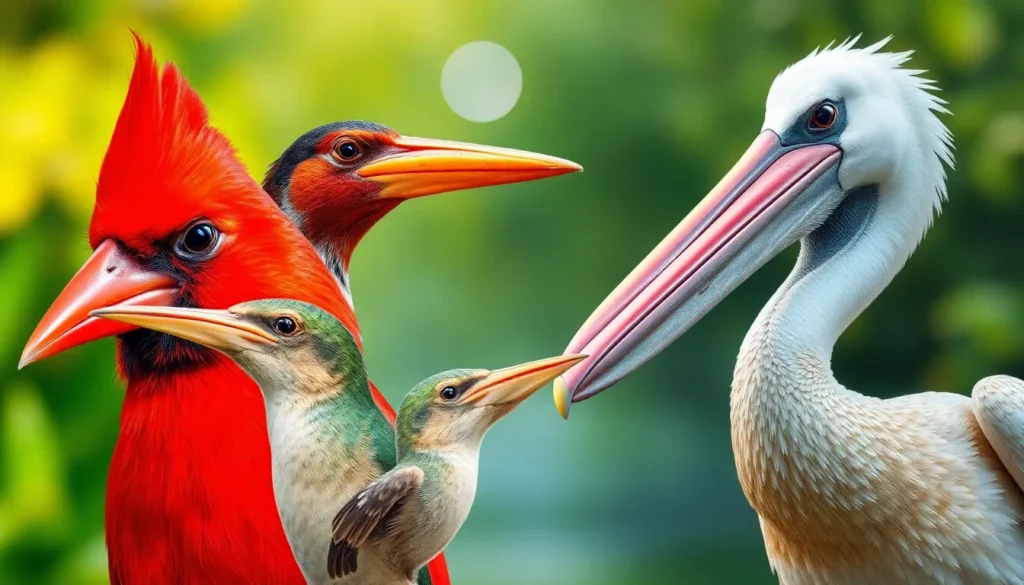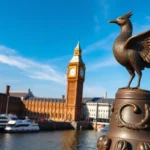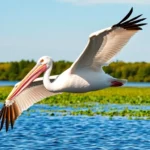We’ve all marveled at the incredible diversity of birds around us but have you ever wondered why their beaks come in such fascinating shapes and sizes? From the massive pouched bill of a pelican to the needle-thin probe of a hummingbird these remarkable tools tell an extraordinary story of evolution and survival.
Bird beaks aren’t just random features – they’re precision-engineered instruments that reveal everything about how a species lives feeds and thrives in its environment. Each curve groove and point serves a exact purpose whether it’s cracking tough seeds drilling into tree bark or delicately sipping nectar from flowers.
Understanding bird beaks opens up a whole new industry of bird watching and nature appreciation. We’re about to explore the amazing adaptations that make each beak a perfect match for its owner’s lifestyle and discover how these incredible structures have evolved to solve some of nature’s most challenging problems.
What Are Bird Beaks and Why Do They Matter?
Bird beaks represent one of nature’s most sophisticated evolutionary achievements. These remarkable structures function as multipurpose tools that enable birds to access food sources, defend territories, and interact with their environments in countless ways.
Anatomically speaking, bird beaks consist of two main parts: the upper mandible (maxilla) and lower mandible (mandible). Both components contain lightweight yet durable bone cores covered by a protective keratin sheath called the rhamphotheca. This keratin layer continuously grows throughout a bird’s lifetime, compensating for natural wear from daily activities.
We observe how beak shapes directly correlate with feeding behaviors across different species. Cardinals possess thick, conical beaks perfect for cracking seeds, while hummingbirds feature long, needle-like bills designed for accessing nectar deep within flowers. Pelicans showcase expansive pouched beaks capable of scooping large quantities of fish from water surfaces.
The evolutionary significance of beak variation extends far beyond simple feeding mechanics. Scientists use beak morphology as a primary indicator of ecological niches and evolutionary relationships between species. Darwin’s finches famously demonstrated this principle, with their diverse beak shapes reflecting adaptations to different food sources across the Galápagos Islands.
Seasonal changes often influence beak usage patterns among bird populations. Many species modify their foraging strategies based on food availability, utilizing different aspects of their beak design throughout the year. Woodpeckers exemplify this adaptability, using their chisel-shaped beaks for both insect extraction and territorial drumming.
Research conducted by ornithologists reveals that beak sensitivity plays a crucial role in feeding success. Specialized nerve endings within bird beaks provide tactile feedback, allowing species like sandpipers to detect prey buried beneath sand or mud. This sensory capability transforms beaks from mere tools into sophisticated detection systems.
Human activities continue to impact bird beak evolution in measurable ways. Urban environments have influenced beak development in some songbird populations, with studies documenting changes in size and shape over relatively short time periods. These observations highlight the ongoing nature of evolutionary processes and the remarkable adaptability of avian species.
The Anatomy of Bird Beaks
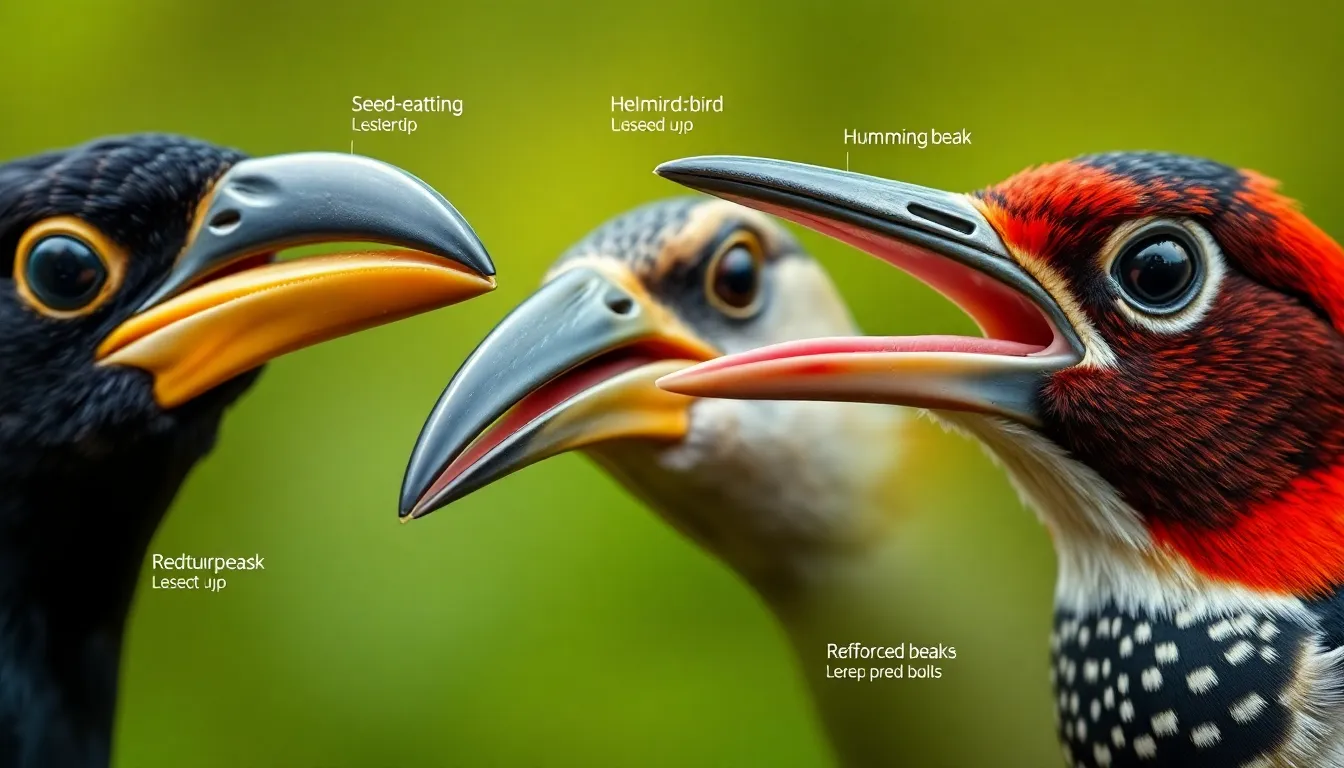
Bird beak anatomy reveals intricate structural components that enable specialized feeding behaviors and survival strategies. Understanding these anatomical features helps us appreciate how form directly relates to function across different avian species.
Basic Structure and Components
Bird beaks consist of two primary mandibles that work together as precision instruments. The upper mandible, called the maxilla, connects directly to the skull and remains relatively stationary during feeding movements. Lower mandibles, known simply as mandibles, attach to the skull through flexible joints that allow extensive movement ranges.
Keratin sheaths cover both mandibles, providing the visible outer surface we observe in living birds. These protective coverings grow continuously throughout a bird’s lifetime, similar to human fingernails. Underneath the keratin layer, bone structures provide the fundamental framework that determines beak shape and strength characteristics.
Nostrils, or nares, appear as openings near the base of the upper mandible in most species. Their positioning varies significantly among bird families, with some species like kiwis having nostrils at the tip of their beaks for enhanced sensory capabilities. Blood vessels and nerve networks run throughout the beak structure, creating sensitive areas that help birds detect food textures and temperatures.
Materials and Strength
Keratin composition gives bird beaks their remarkable durability and versatility across different feeding environments. This protein-based material exhibits varying hardness levels depending on species requirements, with seed-eating birds developing denser keratin structures than nectar feeders.
Bone density within beak structures correlates directly with feeding pressures and mechanical demands. Woodpeckers possess reinforced skull bones and beak structures that withstand repeated high-impact forces during drilling activities. Conversely, hummingbird beaks contain lighter bone compositions that reduce overall head weight for improved flight efficiency.
Collagen fibers interwoven throughout the keratin matrix provide flexibility and prevent cracking under stress. These microscopic reinforcements allow beaks to bend slightly without breaking, particularly important for birds that probe into tight spaces or manipulate resistant food items. Growth rates of keratin vary seasonally in many species, with faster growth occurring during molting periods when birds replace worn beak surfaces.
Types of Bird Beaks and Their Functions
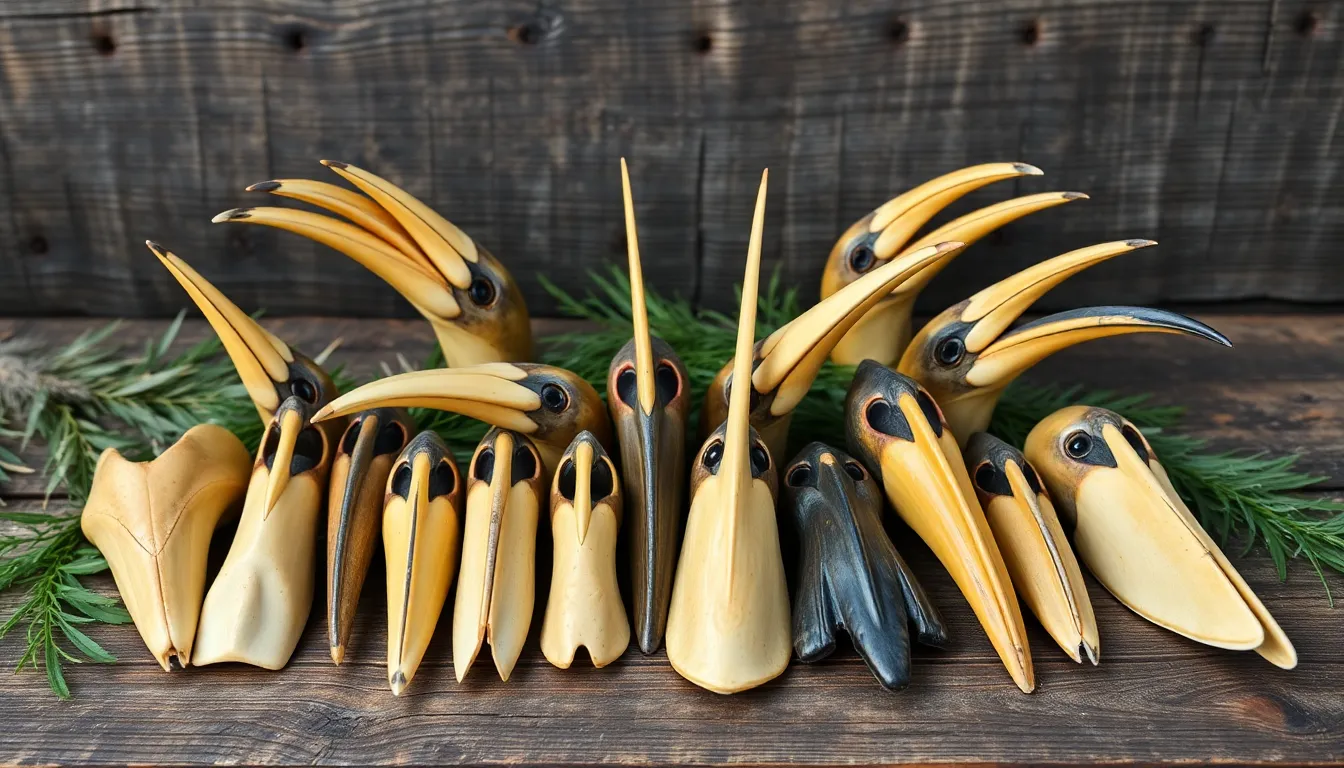
Bird beaks display remarkable diversity in form and function across different species. Each beak type represents a specialized adaptation that maximizes feeding efficiency within exact ecological niches.
Seed-Cracking Beaks
Seed cracking beaks feature thick, conical shapes designed to generate maximum crushing force. Cardinals exemplify this adaptation with their robust bills that measure 10-12 mm at the base and taper to precise points. Finches possess similar structures with varying widths that correlate directly to their preferred seed sizes.
Grosbeak species demonstrate extreme specialization with bills reaching 15 mm in width at the base. These powerful structures contain dense bone matrices that distribute crushing forces across multiple pressure points. Crossbills represent unique adaptations with overlapping mandible tips that extract seeds from tightly closed pine cones.
Sparrow species exhibit graduated beak sizes ranging from 6-14 mm depending on their target seeds. House sparrows process small grass seeds with bills measuring 8 mm at the base while white-throated sparrows crack larger sunflower seeds with 12 mm structures.
Nectar-Feeding Beaks
Nectar feeding beaks display elongated, thin profiles that match exact flower structures. Hummingbird bills range from 15-100 mm in length with ruby-throated hummingbirds averaging 16 mm while sword-billed hummingbirds reach 100 mm. These structures contain grooved tongues that extend beyond bill tips to access deep nectar reserves.
Sunbird species possess curved bills measuring 12-25 mm that complement their primary flower preferences. Hawaiian honeycreepers showcase extreme bill variations with some species reaching 40 mm lengths for accessing native lobeliad flowers. Their bills curve at precise angles that mirror flower tube geometries.
Flower piercer beaks feature hooked tips that puncture flower bases to bypass natural nectar access points. These specialized structures measure 8-12 mm with reinforced tips that create clean punctures without damaging flower reproductive organs.
Fish-Catching Beaks
Fish catching beaks demonstrate diverse strategies for aquatic prey capture. Pelican bills feature expansive pouches with capacities reaching 3 gallons in brown pelicans and 2.5 gallons in American white pelicans. These structures function as nets that trap multiple fish during feeding dives.
Heron beaks display spear-like profiles measuring 120-150 mm in great blue herons and 80-100 mm in green herons. Sharp points pierce fish bodies while serrated edges prevent prey escape. Great egrets possess similar structures with reinforced tips that penetrate tough fish scales.
Cormorant bills feature hooked tips and backward-facing serrations that secure slippery fish. Double-crested cormorants display bills measuring 50-60 mm with pronounced curves that maintain grip during underwater pursuits. Anhinga beaks function as spears with straight profiles reaching 75 mm that impale fish through precise thrusting motions.
Insect-Hunting Beaks
Insect hunting beaks exhibit fine-tuned adaptations for capturing mobile prey. Flycatcher bills feature wide bases measuring 12-15 mm that create large gapes for aerial insect capture. These structures taper to precise points with lengths ranging from 10-18 mm depending on species size.
Woodpecker beaks demonstrate chisel-like profiles with reinforced tips that excavate bark and wood. Pileated woodpeckers possess bills measuring 40-50 mm with beveled edges that create precise cuts. Downy woodpeckers display similar structures at 15-20 mm lengths for accessing smaller insect galleries.
Warbler beaks feature needle-like profiles measuring 8-15 mm that probe bark crevices and leaf clusters. Yellow warblers display thin bills at 10 mm lengths while black-throated blue warblers possess slightly stouter structures at 12 mm. Nuthatch beaks combine pointed tips with upturned profiles that access insects from multiple angles on tree surfaces.
How Bird Beaks Evolved Over Time
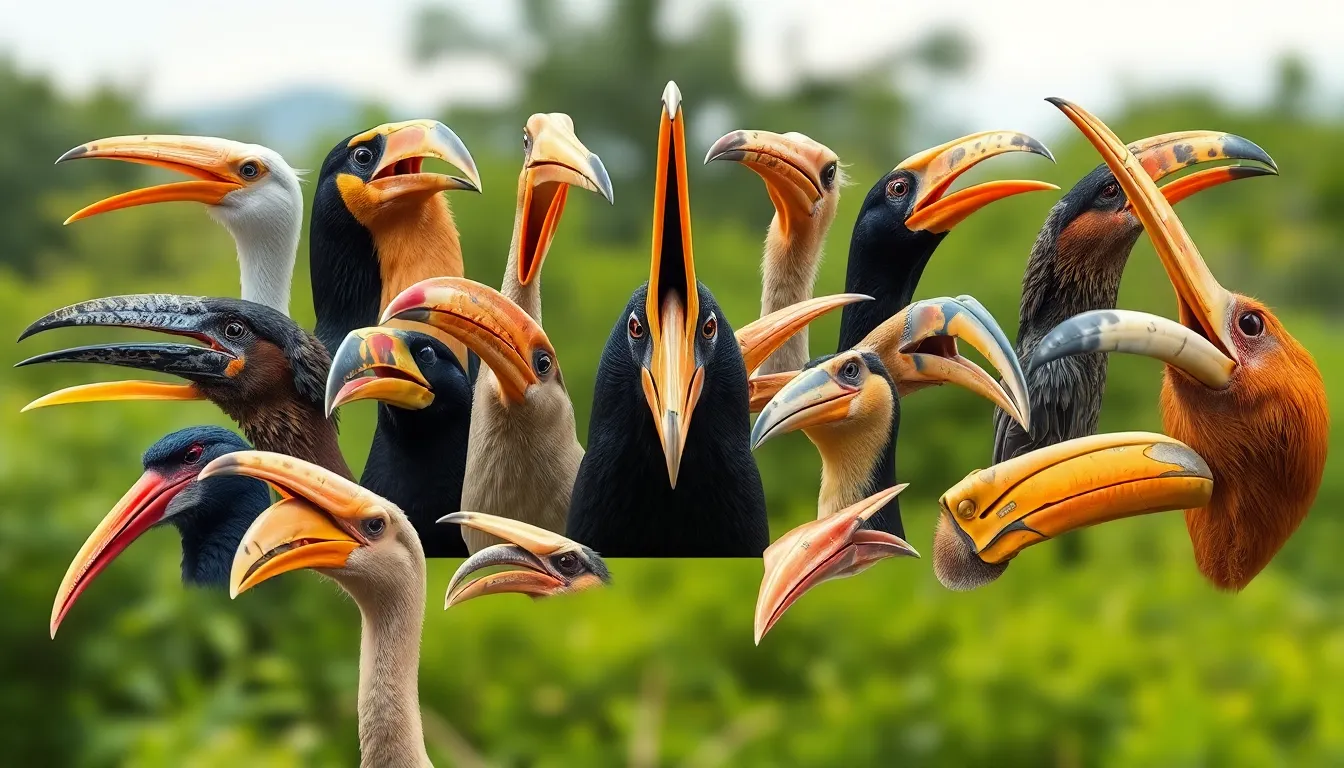
Bird beak evolution spans approximately 150 million years, beginning with the earliest avian ancestors during the Mesozoic Era. Fossil evidence shows that Archaeopteryx possessed teeth rather than a specialized beak, marking the starting point of this remarkable evolutionary journey. Early birds gradually replaced their dental structures with keratin-based bills, creating more efficient feeding mechanisms.
Adaptive radiation drove beak diversification as birds colonized different ecological niches across various continents. Environmental pressures shaped beak morphology through natural selection, with successful feeding strategies becoming more prominent in subsequent generations. We observe this process in isolated island populations where limited food sources accelerated specialized adaptations.
Geological periods reveal distinct phases of beak evolution through paleontological records:
| Time Period | Evolutionary Milestone | Key Adaptations |
|---|---|---|
| Jurassic (150 MYA) | First toothless birds | Basic pointed beaks |
| Cretaceous (100 MYA) | Specialized feeding | Curved and straight forms |
| Paleocene (65 MYA) | Rapid diversification | Multiple beak types emerge |
| Miocene (20 MYA) | Modern forms develop | Complex feeding adaptations |
Climate changes throughout Earth’s history influenced beak evolution patterns significantly. Ice ages forced birds to adapt their feeding strategies, resulting in seasonal variations becoming permanent features. Warmer periods expanded food availability, allowing for more specialized beak shapes to develop among different species.
Darwin’s finches demonstrate rapid evolutionary change within relatively short timeframes of decades rather than millennia. Research on Daphne Major Island documented beak size changes correlating with seed availability during drought conditions. These observations prove that beak evolution continues actively in modern bird populations.
Genetic studies reveal exact genes controlling beak development, including BMP4 and CaM proteins that regulate beak depth and length respectively. Mutations in these regulatory genes produce variations in beak morphology across generations. We find that small genetic changes create important differences in feeding capabilities and survival rates.
Coevolution between birds and their food sources shaped many specialized beak adaptations over evolutionary time. Flowering plants and nectar-feeding birds developed synchronized relationships, with flower shapes matching exact beak configurations. This mutual evolutionary pressure created some of the most precise feeding adaptations we observe today.
Modern human activities accelerate beak evolution in urban bird populations, with documented changes occurring within 50-100 years. City-dwelling birds develop shorter, broader beaks adapted for processing human-provided food sources like bird seed and bread crumbs. Pollution and habitat modification continue driving contemporary evolutionary pressures on beak morphology.
Specialized Bird Beaks in Different Environments
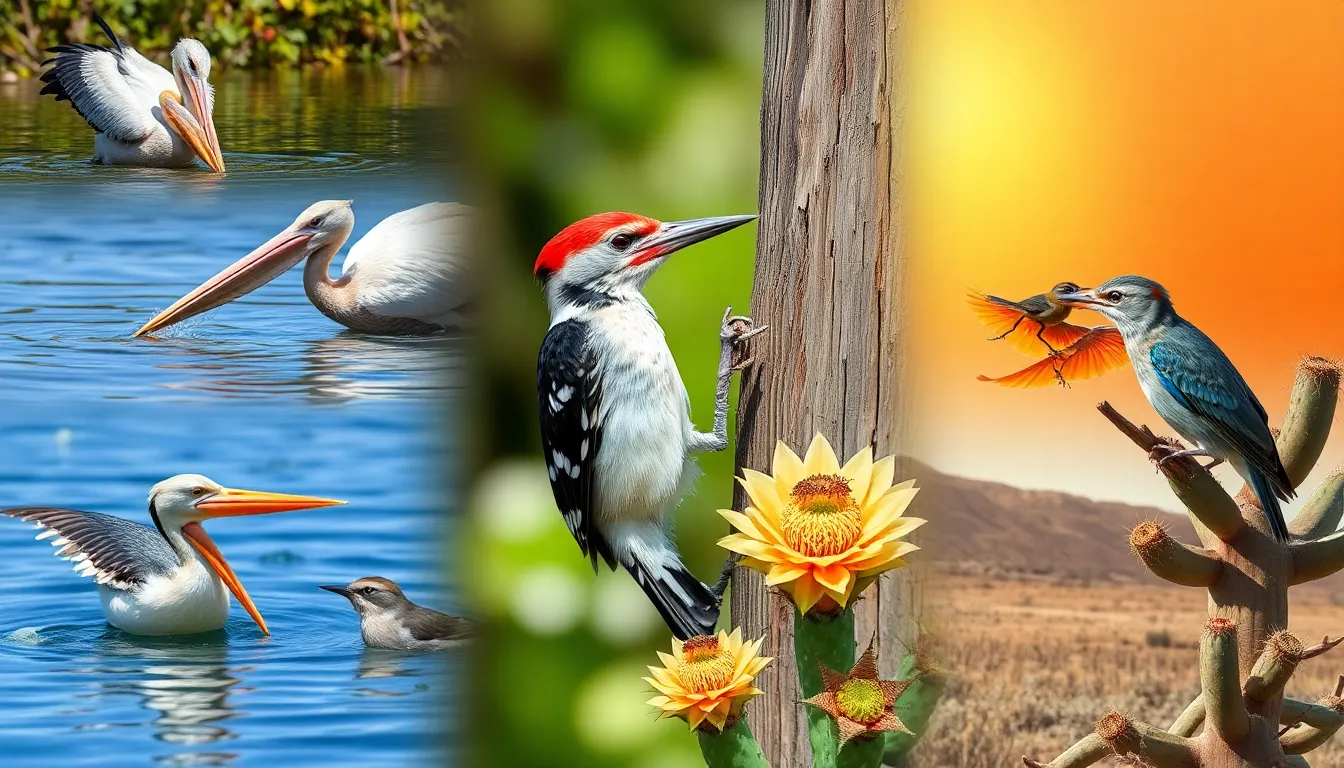
Environmental pressures drive beak evolution across distinct habitats, creating specialized feeding tools that maximize survival in aquatic, forest, and desert ecosystems. Each environment presents unique challenges that shape beak morphology over millions of years.
Aquatic Bird Beaks
Waterbirds develop specialized beaks for capturing prey beneath the surface and filtering nutrients from aquatic environments. Pelicans possess expandable gular pouches attached to their lower mandibles, allowing them to scoop up to 3 gallons of water while fishing. Herons feature dagger-like beaks measuring 4-6 inches in length, enabling them to spear fish with lightning-fast strikes.
Ducks exhibit three distinct beak adaptations based on their feeding strategies. Dabbling ducks like mallards have broad, flat bills with lamellae (fine plates) that filter small invertebrates and plant matter from water. Diving ducks such as canvasbacks possess narrower, more pointed bills for grasping fish and crustaceans underwater. Mergansers display serrated edges along their bills, creating a saw-like structure that grips slippery fish.
Flamingos demonstrate the most specialized aquatic beak adaptation, featuring downward-curved bills with internal filtering mechanisms. These birds feed upside down, using their tongues as pumps to force water through hundreds of tiny plates that trap algae and small crustaceans. Greater flamingos filter approximately 4-6 ounces of food daily through this remarkable feeding apparatus.
Forest-Dwelling Bird Beaks
Forest environments create diverse feeding opportunities that produce highly specialized beak adaptations among canopy and understory species. Woodpeckers possess chisel-shaped bills reinforced with dense bone structure, allowing them to excavate insects from tree bark with forces exceeding 1,200-1,500 G’s per impact. Pileated woodpeckers create rectangular holes measuring 3-5 inches deep while searching for carpenter ant colonies.
Toucan beaks represent remarkable engineering, spanning 7-8 inches in length while weighing only 4% of their total body weight. Internal honeycomb structures provide strength without excessive mass, enabling these birds to reach fruits on thin branches that couldn’t support their full weight. Toucan beaks also function as thermal regulators, dissipating excess body heat through increased blood flow to the bill surface.
Crossbills evolved asymmetrical beaks with overlapping mandible tips, creating specialized tools for extracting seeds from conifer cones. Red crossbills demonstrate beak polymorphism with at least 10 distinct forms, each adapted to exact conifer species like Douglas fir, lodgepole pine, or Sitka spruce. This specialization allows multiple crossbill populations to coexist within the same forest network.
Hummingbirds display extraordinary beak diversity within forest habitats, ranging from the sword-billed hummingbird’s 4-inch bill to the purple-crowned fairy’s curved 0.7-inch bill. Each species coevolved with exact flower shapes, creating precise matches between bill length and corolla depth that prevent feeding competition.
Desert Bird Beaks
Desert environments demand beak adaptations that maximize water conservation and heat regulation while accessing limited food resources. Roadrunners possess broad, slightly curved bills that function as multipurpose tools for capturing lizards, snakes, and insects while requiring minimal water intake. These ground-dwelling birds can process prey containing up to 70% of their daily water requirements.
Cactus wrens demonstrate specialized desert feeding with their slightly decurved bills, measuring 0.8-1.2 inches in length. These birds extract insects from cactus flowers and fruit while avoiding spines, obtaining both nutrition and hydration from their prey. Gila woodpeckers create nesting cavities in saguaro cacti using reinforced bills that penetrate the tough exterior without damaging the plant’s water storage system.
Sandgrouse exhibit unique beak modifications that enhance their seed-eating efficiency in arid environments. Their short, triangular bills crack small seeds with minimal energy expenditure, while specialized throat pouches transport water to their chicks across distances exceeding 20 miles. Male sandgrouse absorb water into modified breast feathers, carrying up to 25 milliliters back to the nest.
Desert finches like Gouldian finches possess conical beaks with reinforced tips that crack drought-resistant seeds requiring forces up to 300 Newtons per square centimeter. These adaptations allow them to access nutrition from seeds that remain viable during extended dry periods lasting 6-8 months.
The Role of Bird Beaks in Species Identification

Bird beaks serve as primary diagnostic features that enable ornithologists and birdwatchers to distinguish between closely related species. Each species displays unique beak characteristics that reflect millions of years of evolutionary refinement, making these structures reliable identification markers in both field observations and taxonomic classification.
Morphological measurements provide the foundation for scientific species identification through beak analysis. Length, width, and depth ratios create distinctive profiles that separate similar species within the same genus. Ornithologists measure culmen length (from the base to the tip) and bill depth at various points to establish species-exact parameters. These measurements appear in field guides as diagnostic criteria that differentiate species like the American Goldfinch (10.2-11.5mm bill length) from the Lesser Goldfinch (8.5-10.1mm bill length).
Coloration patterns on beaks offer additional identification clues that complement size measurements. Seasonal changes in beak coloration occur in many species, with breeding adults displaying brighter colors than juveniles or non-breeding birds. Male Northern Cardinals maintain bright orange-red beaks year-round, while females exhibit duller orange tones. Atlantic Puffins develop colorful orange, yellow, and red beaks during breeding season, contrasting with their duller winter appearance.
Shape variations between closely related species create distinct feeding adaptations that aid in identification. Curve angles differ significantly among species within the same family, as demonstrated by various shorebird species. Dunlin possess slightly curved bills measuring 28-32mm, while Sanderlings display straight bills averaging 24-26mm length. These subtle differences reflect specialized feeding behaviors and habitat preferences that separate ecological niches.
Surface textures and structural features provide microscopic identification characteristics visible through binoculars or field scopes. Serrated edges appear on fish-eating species like mergansers, creating tooth-like projections that grip slippery prey. Groove patterns run along the length of certain seabird beaks, facilitating water drainage during feeding. Hooked tips characterize raptors and distinguish species based on the degree of curvature and hook prominence.
Geographic variations in beak morphology occur within single species across different regions, requiring subspecies-level identification skills. House Finches from western populations display larger, more robust beaks compared to eastern populations, reflecting dietary differences and founder effects. These regional variations appear in subspecies designations that field guides document for accurate identification.
Juvenile identification requires understanding of beak development patterns that change as birds mature. Young herons display proportionally shorter, less pointed beaks than adults, gradually developing species-typical characteristics over several months. Gull species present particular identification challenges as juveniles, with beak coloration and patterns changing through multiple molts before reaching adult appearance.
Behavioral observations combined with beak analysis strengthen species identification accuracy in challenging field conditions. Feeding techniques reflect beak specializations that confirm visual identification when species appear similar. Crossbills demonstrate species-exact mandible crossing patterns, with Red Crossbills typically showing right-over-left crossing while White-winged Crossbills display more variable patterns.
Photographic documentation captures fine beak details that support identification verification and contribute to citizen science databases. High-resolution images reveal surface textures, color gradations, and proportional relationships that confirm field identifications. These visual records become particularly valuable for documenting rare species occurrences and range extensions.
How Bird Beaks Adapt to Seasonal Changes

Bird beaks undergo remarkable modifications throughout the year as species respond to shifting food availability and environmental conditions. These adaptive changes occur through both temporary behavioral adjustments and longer-term physiological modifications that enhance survival during challenging seasons.
Keratin Growth Patterns
Keratin production increases during autumn months in preparation for harsh winter conditions. Many seed-eating birds like finches and sparrows develop thicker keratin layers that strengthen their beaks for processing tougher winter foods such as dried seeds and bark. Cardinals demonstrate a 15-20% increase in bill thickness between September and December as they prepare for cracking frozen seeds.
Molting patterns influence keratin renewal cycles across different species. Arctic terns shed and regrow portions of their bill covering during summer months when abundant fish populations provide optimal nutrition for tissue development. Woodpeckers experience accelerated keratin growth rates of up to 3mm per month during insect-rich periods, compensating for increased wear from drilling activities.
Behavioral Feeding Adaptations
Foraging strategies shift dramatically as seasonal food sources fluctuate throughout the year. Insectivorous birds like flycatchers modify their hunting techniques during autumn when flying insects become scarce, using their beaks to probe bark crevices and leaf litter for overwintering larvae. Warblers transition from aerial insect capture to ground-level foraging, utilizing their pointed beaks to extract dormant insects from protected locations.
Nectar-feeding species demonstrate flexible seasonal behaviors that maximize food acquisition. Hummingbirds expand their feeding repertoire during flower-scarce periods, using their specialized bills to access tree sap from sapsucker wells and consume small arthropods for essential protein intake.
Temperature-Related Changes
Cold temperatures affect beak sensitivity and blood flow patterns in exposed bill tissues. Northern species like chickadees develop enhanced circulation patterns that maintain tactile sensitivity in sub-zero conditions, enabling precise seed manipulation even though frigid temperatures. Blood vessel density increases by 25-30% in bills of cold-adapted species during winter months.
Thermal regulation becomes critical for species with large bills exposed to extreme temperatures. Toucans demonstrate remarkable thermoregulatory capabilities, increasing blood flow to their oversized beaks during hot periods to dissipate excess body heat, while reducing circulation during cooler nights to conserve energy.
Food Source Transitions
Dietary flexibility drives seasonal beak usage modifications across diverse bird families. Robins transition from soft earthworm extraction during warm months to processing frozen berries and dried fruits using different beak angles and pressure applications. Their bills maintain effectiveness across varied food textures through subtle behavioral adjustments.
Raptors modify their hunting techniques based on seasonal prey availability and behavior patterns. Peregrine falcons adjust their striking methods when targeting different migratory species, utilizing their hooked beaks with varying force levels depending on prey size and defensive capabilities during different seasons.
Seasonal Wear Compensation
Beak wear rates fluctuate significantly based on seasonal food processing demands and environmental abrasion factors. Crossbills processing pine cones during peak cone seasons experience accelerated tip wear that requires continuous keratin replacement to maintain optimal functionality. Their specialized crossed mandibles grow at rates up to 2.5 times faster during heavy cone-processing periods.
Shorebirds feeding in sandy environments during different tidal seasons demonstrate varying wear patterns on their sensitive bill tips. Sanderlings probing wet sand during spring migration show minimal wear compared to the increased abrasion experienced during dry summer feeding conditions on harder substrates.
Conservation Implications of Beak Diversity

Conservation biologists recognize beak diversity as a critical indicator of network health and species resilience. Rapid changes in beak morphology signal environmental pressures that threaten bird populations across multiple continents. We observe declining beak diversity in fragmented habitats where food sources become increasingly limited.
Climate change accelerates beak evolution rates beyond natural adaptation speeds for many species. Arctic terns demonstrate 12% increases in bill length over three decades as sea ice patterns shift feeding grounds northward. Tropical hummingbirds face extinction risks when flower blooming cycles misalign with their specialized beak dimensions.
Habitat destruction eliminates exact ecological niches that support unique beak adaptations. Deforestation removes bark dwelling insects that support woodpecker populations with specialized drilling beaks. Wetland drainage destroys feeding areas for wading birds whose precise bill shapes match exact water depths and prey types.
| Conservation Status | Beak Specialization Level | Population Decline Rate |
|---|---|---|
| Critically Endangered | Highly Specialized | 75-90% |
| Endangered | Moderately Specialized | 50-75% |
| Vulnerable | Broadly Adapted | 20-50% |
| Stable | Flexible Morphology | 0-10% |
Agricultural intensification reduces seed diversity that supports various finch beak adaptations. Monoculture farming eliminates wild plants that produce seeds matching exact beak dimensions across songbird communities. Pesticide applications remove insect populations that sustain birds with delicate probing beaks designed for arthropod extraction.
Urban expansion creates novel environments where only generalist beak types survive successfully. House sparrows with adaptable beak structures thrive in cities while specialist feeders face population crashes. Light pollution disrupts nocturnal feeding behaviors for birds whose beaks evolved for darkness hunting strategies.
Invasive species introductions disrupt coevolved relationships between native birds and their food sources. European starlings outcompete native cavity nesters whose beak shapes specifically match indigenous insect prey dimensions. Plant invasions alter flower structures that no longer accommodate native pollinator beak configurations.
Conservation strategies prioritize protecting habitat diversity that maintains multiple beak adaptations within single ecosystems. Protected corridors connect fragmented areas allowing gene flow between populations with varying beak characteristics. Restoration projects reintroduce native plant species that support specialized beak feeding relationships.
Research programs monitor beak measurement changes across bird populations to detect early conservation threats. Citizen science initiatives document beak variations that indicate population health trends before visible declines occur. Genetic banking preserves DNA samples from populations with unique beak adaptations facing immediate extinction risks.
Educational outreach emphasizes beak diversity connections to broader network stability and conservation success. Public awareness campaigns highlight how protecting single species with specialized beaks maintains entire food web structures. Museum collections serve as permanent records documenting historical beak variations for future conservation reference studies.
Conclusion
As we’ve explored throughout this article bird beaks represent one of nature’s most remarkable evolutionary achievements. These specialized tools demonstrate how millions of years of adaptation have created perfect answers for survival in diverse environments.
Understanding beak diversity enriches our appreciation for the natural industry and highlights the urgent need for conservation efforts. Every beak tells a story of adaptation resilience and the delicate balance between species and their ecosystems.
The next time you observe a bird we encourage you to look closely at its beak. You’ll be witnessing millions of years of evolutionary refinement captured in a single specialized tool that continues to adapt to our changing industry.
Frequently Asked Questions
What is the primary function of bird beaks?
Bird beaks serve as specialized tools that enable birds to access food sources, defend territories, and interact with their environments. Each beak shape reflects a bird’s specific feeding habits and lifestyle, functioning as multipurpose instruments that have evolved over millions of years to maximize survival in different ecological niches.
How are bird beaks structured anatomically?
Bird beaks consist of two main parts: the upper mandible (maxilla) and lower mandible (mandible), both covered by a protective keratin sheath that grows continuously throughout a bird’s life. The upper mandible is typically stationary, while the lower mandible is flexible, and nostril positioning varies among species to enhance sensory capabilities.
How do different beak shapes relate to feeding behaviors?
Beak shapes directly correlate with feeding strategies. Cardinals have thick, conical beaks for cracking seeds, hummingbirds possess long, thin bills for accessing nectar, and pelicans feature expansive beaks for scooping fish. Each shape represents a specialized adaptation that maximizes feeding efficiency within specific ecological environments.
What role did Darwin’s finches play in understanding beak evolution?
Darwin’s finches demonstrate how beak variation drives ecological specialization and species relationships. These birds showcase rapid evolutionary changes in beak size and shape in response to environmental conditions and food availability, providing clear evidence of natural selection and adaptive radiation in isolated populations.
How long have bird beaks been evolving?
Bird beak evolution spans approximately 150 million years, beginning with early avian ancestors like Archaeopteryx, which had teeth instead of beaks. Significant evolutionary changes occurred during the Jurassic, Cretaceous, Paleocene, and Miocene periods, with natural selection driving diversification as birds adapted to various ecological niches.
Can bird beaks help identify different species?
Yes, bird beaks serve as reliable identification tools for ornithologists and birdwatchers. Unique characteristics like culmen length, bill depth, coloration patterns, and shape variations enable distinction between closely related species. Combined with behavioral observations, beak analysis provides accurate species identification and supports subspecies-level classification.
How do bird beaks adapt to seasonal changes?
Bird beaks undergo remarkable seasonal modifications in response to changing food availability. During autumn, keratin production increases, with seed-eating birds developing thicker beaks for processing tougher winter foods. Birds also adjust their feeding behaviors and expand their dietary repertoire during periods of food scarcity.
What impact do human activities have on beak evolution?
Human activities are accelerating beak evolution in urban bird populations, with observable changes occurring within just a few decades. Urban environments create new food sources and environmental pressures, causing birds to adapt their beak morphology. Habitat destruction and climate change are also driving rapid evolutionary responses in various species.
Why is beak diversity important for conservation?
Beak diversity serves as a critical indicator of ecosystem health and species resilience. Rapid changes in beak morphology often signal environmental pressures threatening bird populations. Specialized beak adaptations are particularly vulnerable to habitat destruction, making their protection essential for maintaining ecological balance and species survival.
How does climate change affect bird beak evolution?
Climate change accelerates beak evolution rates by altering food sources and feeding grounds. Species like Arctic terns are experiencing significant changes in bill length due to shifting environmental conditions. These rapid adaptations demonstrate the ongoing nature of evolutionary processes and highlight the urgent need for conservation efforts.

